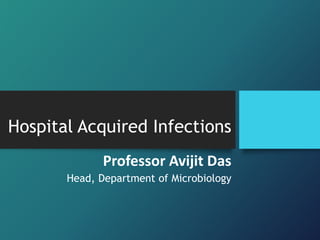
Hospital Acquired Infections Lecture Slide.pdf
- 1. Hospital Acquired Infections Professor Avijit Das Head, Department of Microbiology
- 2. Definition CDC definition of hospital acquired infections. APIC Infection Control and Applied Epidemiology: Priciples and Practice St. Louis: Mosby; 1996:A-1-20 Hospital acquired infection is a localized or systemic condition that results from adverse reaction to the presence of an infectious agent(s) or its toxin(s) that was not present or incubating at the time of admission to the hospital.
- 3. Hospital acquired infections (Special situations) Infection that is acquired in the hospital but does not become evident until after hospital discharge. Infection in a neonate that results from passage through the birth canal.
- 4. Special situations (not hospital acquired infections) Infection that is associated with a complication or extension of infection already present on admission, unless a change in pathogen or symptoms strongly suggests the acquisition of a new infection. In an infant, an infection that is known or proved to have been acquired transplacentally.
- 5. Influencing factors The microbial agent The likelihood of exposure leading to infection depends partly on the characteristics of the microorganisms including resistance to antimicrobial agents, intrinsic virulence and amount (inoculum) of infective material. Patient susceptibility Important patient factors influencing acquisition of infection include age and immune status, underlying disease, diagnostic and therapeutic interventions etc. Environmental factors These factors include contaminated air-conditioning system, contaminated water system etc.
- 6. Methods of transmission in the health-care setting
- 7. Contact transmission Transmission between a susceptible and an infected or colonized person.
- 8. Droplet transmission Droplets generated by coughing, sneezing etc.
- 9. Vector transmission Transmitted through insects and other invertebrate animals.
- 10. Common vehicle transmission Transmitted by contaminated materials such as blood products, contaminated instruments etc.
- 11. Pathological agents • Bacteria (most common nosocomial pathogens): Commensal bacteria- Staphylococcus epidermidis (causes I.V. infections), Escherichia coli (causes UTI). Pathogenic bacteria- Gram-positive bacteria: Staphylococcus aureus (causes infection in soft tissue, bone, blood stream etc. Frequently become resistant to antibiotics), anaerobic bacterium such as Clostridium causes gangrene.
- 12. Gram-negative bacteria: Enterobacteriaceae, Pseudomonas etc. may colonize when the host defenses are compromised. They may also be highly antibiotic resistant. Legionella species may cause pneumonia. Viruses: There is possibility of nosocomial transmission of hepatitis B and C viruses (transfusion, dialysis, injection etc.), rotavirus and enterovirus (through oro-faecal route). Parasites and fungi. Pathological agents
- 13. Most common sites of hospital acquired infections
- 14. Urinary tract infections • The most common hospital acquired infection. • 80% is associated with the use of an indwelling bladder catheter.
- 15. Urinary tract infections Causative organisms Gram-positives Enterococcus species (14.3%) Coagulase negative staphylococcus (3.1%) Staphylococcus aureus (1.4%) Gram-negatives Escherichia coli (18.5%) Pseudomonas aeruginosa (10.3%) Klebsiella pneumoniae (5.2%) Enterobacter species (4%) Citrobacter species (2%) Others (5.2%) Fungi Candida albicans (15.3%) Candida galbrata (3.5%) Other candida species (6%)
- 16. Surgical site infections • They are also frequent. • 2/100 operations (NNIS-2006, CDC). • The infection is acquired during operation itself either exogenously (e.g. from air, medical equipment etc.) or endogenously from flora on the skin or rarely from blood used in surgery.
- 17. Causative organisms Gram-positives Enterococcus species (17.1%) Coagulase negative staphylococcus (11.7%) Staphylococcus aureus (8.8%) Others (9.2%) Gram-negatives Escherichia coli (8.5%) Pseudomonas aeruginosa (9.6%) Klebsiella pneumoniae (3.9%) Enterobacter species (8.4%) Fungi Candida albicans (5.9%) Candida galbrata (1.3%) Other candida species (1.7%) Aspergillus species (0.1%) Other fungi (1.7%) SURGICAL SITE INFECTIONS
- 18. Hospital acquired pneumonia The most important are patients on ventilators in intensive care units, where the rate of pneumonia is 3% per day.
- 19. Hospital acquired pneumonia Causative organisms Gram-positives Staphylococcus aureus (17%) Streptococcus pneumoniae (1.6%) Enterococcus species (1.8%) Gram-negatives Escherichia coli (4.4%) Pseudomonas aeruginosa (15.6%) Klebsiella pneumoniae (7%) Enterobacter species (10.9%) Acinetobacter (2.9%) Citrobacter (1.4%) Serratia (4.3%) Other (15.7%) Fungi Candida albicans (5.7%) Candida galbrata (0.2%) Other candida species (1%) Aspergillus species (0.5%) Other fungi (2.5%)
- 20. Health-care associated blood stream infections In Intensive care unit • 5.9/1000 catheter • Attributable mortality 12-25% (NNIS-2006, CDC)
- 21. Causative organisms Gram-positives Enterococcus species (11%) Coagulase negative staphylococcus (39%) Staphylococcus aureus (12%) Gram-negatives Escherichia coli (2.2%) Pseudomonas aeruginosa (3.7%) Klebsiella pneumoniae (2.3%) Enterobacter species (3.8%) Fungi Candida albicans (6.1%) Candida galbrata (1.8%) Other candida species (3.6%) Blood stream infections
- 22. Ear, nose & throat infections Causative organisms Gram-positives Enterococcus species (4.9%) Coagulase negative staphylococcus (15%) Staphylococcus aureus (13%) Streptococcus pneumoniae (0.5%) Gram-negatives Escherichia coli (2.6%) Pseudomonas aeruginosa (10.3%) Klebsiella pneumoniae (3.4%) Enterobacter species (7.2%) Haemophilus influenzae (2%) Fungi Candida albicans (2%) Candida galbrata (1.4%) Other candida species (1.7%) Aspergillus species (0.3%) Other (2%)
- 23. Who is affected by hospital acquired infections? Nosocomial infections typically affect patients who are immunocompromised because of age, underlying diseases, or medical or surgical treatments.
- 24. Root causes of hospital acquired infections (1) Lack of training in basic infection control. Lack of an infection control infrastructure and poor infection control practices (procedures). Inadequate facilities and techniques for hand hygiene. Lack of isolation precautions and procedures.
- 25. Root Causes of Nosocomial Infections (2) Use of advanced and complex treatments without adequate training and supporting infrastructure, including— Invasive devices and procedures Complex surgical procedures Interventional obstetric practices Intravenous catheters, fluids, and medications Urinary catheters Mechanical ventilators Inadequate sterilization and disinfection practices and inadequate cleaning of hospital.
- 26. • General cleaning and disinfection of the ward. • Maintenance of sterility of surgical instruments, invasive devices etc. • Proper dressing technique. • Limiting antimicrobial prophylaxis during perioperative period. • Use of narrow spectrum antibiotic once a pathogen is recovered. Prevention of hospital acquired infections